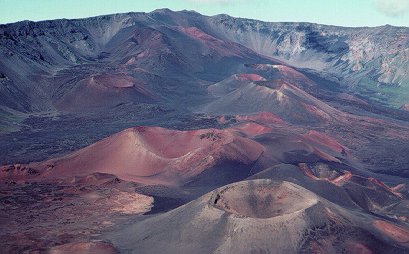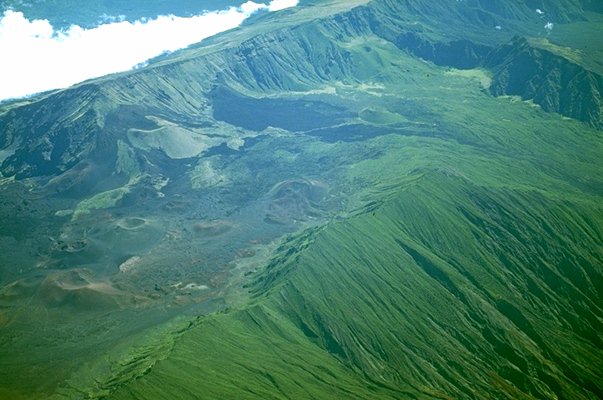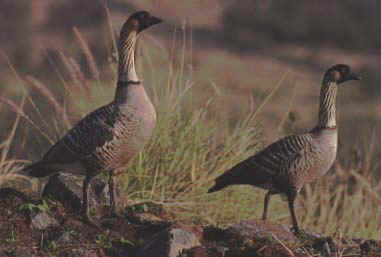 Maui Magic
Maui Magic 
 Maui Magic
Maui Magic 
 |
The main crater area on top of Haleakala, visible from the National Park overlook. |
 |
Smaller craters along the gently sloping sides of the volcano |
Haleakala National Park slices up volcanic Mt. Haleakala, a dramatic scurry to the clouds from sea level to 10,000 feet over a distance of 35 miles. The crater is actually an erosion-carved valley studded with cinder cones that are the results of minor eruptions. The environment in the crater is light-filled and dry, frequently described as other-worldly. Hiking here is a transcendent experience, making it easy to understand why this is one of the especially sacred places for native Hawaiians.
The 10,000 foot summit above is reachable by automobile - a classic scenic drive. Maui's "highway to heaven," rising up into the misty cloud hovering on Haleakala (the house of the Sun), is the worl'ds most rapidly ascending road. It makes you realize that eastern Maui really is a mountain, and you're driving up the slopes of the largest dormant volcano in the world. Along the way are breathtaking overlooks until you finally reach the top, the best overlook of all, and on a clear day can include all of the other Hawaiian islands. The view down and out is magnificent, but many come at night to look up: Haleakala offers perhaps the most easily accessible high-altitude skywatching on the planet.
The environment changes rapidly and dramatically with the altitude, from subtropical rainforest at sea level to subalpine desert in the crater. Every inch of the park makes for extraordinary exploration. 19,270 of Haleakala National Park's 28,655 acres are wilderness.
| Bird and wildlife watching are great at Haleakala. In fact, Haleakala National Park is one of a few places to see rare Hawaiian birds like the endangered state bird the NeNe pictured here. After dark, watch the tree tops on moonlit nights for one of only two native mammals in Hawaii, the peapea, or Hawaiian Hoary bat. On summer nights stop at Leleiwi overlook and listen for the rare Uau, or Dark-Rumped petrel, calling for its mate along the cliffs below. During the winter months watch for Humpback Whales from the porch of the Kipahulu Ranger Station. |  |
    |
   |